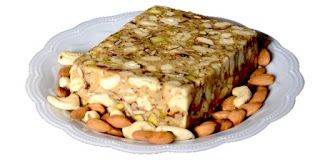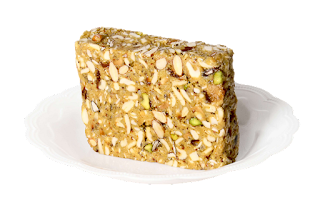Amingad Karadant: A Culinary Masterpiece from Karnat
Karadantu: A Culinary Gem from Karnataka
Karadantu is a culinary gem from the southern Indian state of Karnataka, known for its unique blend of flavors and cultural significance. This traditional sweet treat has a rich history that dates back to the royal kitchens of the Mysore Palace. Its name Karadantu is derived from the Kannada words "kara," meaning fried, and "datnu," meaning gum, alluding to the roasted edible gum used in its preparation.
Ingredients and Preparation:
Karadantu is crafted from a few simple yet wholesome ingredients, including edible gum, jaggery (unrefined sugar), and a variety of dry fruits and nuts. These nuts typically include almonds, cashews, and pistachios, along with dried figs and copious amounts of ghee (clarified butter).
The process begins with roasting the edible gum, giving it a unique roasted flavor and a slightly crunchy texture. The roasted gum is then mixed with finely chopped or ground nuts and dried fruits, which add a delightful nutty and chewy element to the sweet.
Texture and Flavor:
What sets Karadantu apart is its texture and flavor profile. It's characterized by a slightly crumbly and flaky texture with a rich, sweet taste. The roasted gum provides a pleasant crunch, while the dry fruits and nuts offer a delightful nuttiness and a satisfying chewiness. The use of jaggery instead of regular sugar imparts a distinct earthy sweetness that balances the overall flavor.
 |
| kardantu |
Karadantu comes in various forms, often molded into small, rectangular blocks or cubes, and it's not uncommon to find it garnished with edible silver or gold foil, adding a touch of opulence to this humble sweet.
Cultural Significance:
Karadantu is not merely a sweet treat; it holds cultural significance in Karnataka. It's a staple during festivals, weddings, and other auspicious occasions. In fact, it's a customary gift exchanged among friends and relatives during festivities as a token of goodwill and celebration.
Moreover, Karadantu reflects the culinary heritage of Karnataka, showcasing the state's rich and diverse food culture. It embodies the flavors, traditions, and craftsmanship that have been passed down through generations.
Amingad Karadant: A Regional Specialty:
While Karadantu is beloved throughout Karnataka, there is a regional variation that deserves special mention—Amingad Karadant. Amingad is a town located in the Bagalkot district of Karnataka, and it has gained acclaim for its unique take on this traditional sweet.
Amingad Karadant preserves the essence of Karadantu while adding its own twist. It follows the traditional preparation method of roasting edible gum and combining it with an assortment of dry fruits and nuts. What distinguishes Amingad Karadant is the meticulous craftsmanship that goes into its creation.
The Meticulous Craftsmanship:
Amingad Karadant artisans take pride in their intricate and artistic approach to crafting this sweet. Each block of Amingad Karadant is a masterpiece, showcasing both flavor and design. Skilled hands mold the mixture into various shapes, often depicting local motifs and patterns. These shapes not only make the sweet visually appealing but also symbolize the rich cultural heritage of the region.
Amingad Karadant offers a delightful blend of taste and aesthetics. It's a sweet treat that appeals not only to the palate but also to the eyes, making it a popular choice for gifting and celebrating special occasions
Assorted Dry Fruit Sweets: A Nutty Symphony:
In the realm of Indian sweets, there's a delightful category known as assorted dry fruit sweets. These confections are a symphony of flavors and textures, combining the richness of dry Indian fruits and the sweetness of traditional Indian sweets. While the specific recipes and names may vary across regions, the essence remains the same—nuttiness, sweetness, and indulgence.
Ingredients and Varieties:
Assorted dry fruit sweets typically feature a combination of dried fruits such as almonds, cashews, pistachios, dates, figs, and apricots. These dried fruits are often finely chopped, ground, or blended into the base sweet, which can be made from ingredients like mawa (milk solids), khoya (reduced milk), gram flour, or ghee (clarified butter).
The result is a mouthwatering array of sweets, each with its own unique flavor and texture. Some popular varieties include:
1. Badam Barfi:A rich, diamond-shaped sweet made from ground almonds and sugar, often garnished with slivered almonds.2.Anjeer Burfi:A fig-based sweet with a fudgy consistency, studded with chopped pistachios or almonds.3. Dates and Nuts Ladoo:A healthy and energy-boosting sweet made from dates, assorted nuts, and desiccated coconut, rolled into bite-sized balls.4. Kaju Katli: A classic favorite made from cashew nuts, sugar, and ghee, resulting in smooth, diamond-shaped delights.
Nutrition and Indulgence:
Assorted dry fruit sweets offer a balance between nutrition and indulgence. Dried fruits are a powerhouse of nutrients, including essential vitamins, minerals, and dietary fiber. When combined with the sweetness of traditional Indian sweets, they create a delightful treat that is not only delicious but also provides a burst of energy.
These sweets are often enjoyed during festivals, weddings, and special occasions, where they symbolize prosperity, happiness, and the sweetness of life. The nutty textures and rich flavors make them a favorite among people of all ages.
Homemade Sweets Near Me: A Taste of Nostalgia:
In today's fast-paced world, the charm of homemade sweets holds a special place in our hearts. The idea of indulging in treats made with love and care, often following treasured family recipes, evokes a sense of nostalgia and comfort.
The Allure of Homemade Sweets:
Homemade sweets are a testament to the culinary traditions and cultural heritage of a region or community. They vary widely, reflecting the diversity of India's food landscape. Whether it's the aromatic gulab jamuns soaked in syrup, the fragrant besan ladoos, or the crispy jalebis that melt in your mouth, each homemade sweet is a labor of love.
What sets homemade sweets apart is the personal touch. They are often prepared for special occasions, festivals, and family gatherings, where they become a means of celebration and togetherness. Every household has its own secret recipes, techniques, and variations that have been passed down through generations.
The Convenience of Homemade Sweets Near Me
In recent times, the availability of homemade sweets has expanded beyond the confines of one's own kitchen. Many communities and individuals have ventured into small-scale sweet-making businesses, offering their homemade creations to a wider audience.
This convenience of having homemade sweets near me allows people to relish the nostalgia of homemade treats without the effort of preparation. It's an opportunity to savor the authentic flavors and textures of traditional sweets made with care and expertise.
The Joy of Gifting and Sharing
Homemade sweets also hold a special place in the tradition of gifting. They are cherished gifts exchanged during festivals, as tokens of appreciation, or as sweet gestures of love and goodwill. When you present someone with a box of homemade sweets, you're not just offering a



Comments
Post a Comment